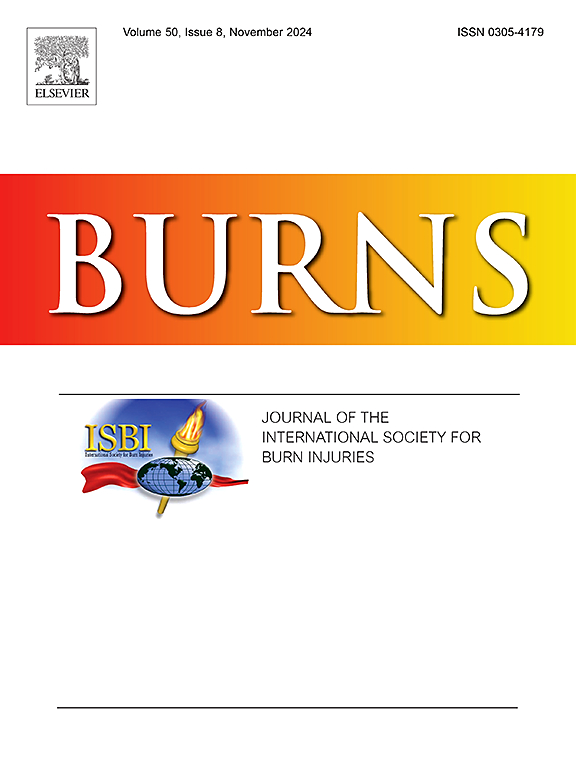The effect of virtual reality and music on pain, anxiety, and pain-related anxiety in burn patient care
IF 2.9
3区 医学
Q2 CRITICAL CARE MEDICINE
引用次数: 0
Abstract
This study was conducted with a pre-test, post-test, randomized controlled experimental design to determine the effects of virtual reality and music on pain, anxiety, and pain-related anxiety in burn patient care. Between May 2022 and May 2023, 120 patients who voluntarily applied to the Burn Unit of a City Hospital in Istanbul were selected based on power analysis. They were divided into three groups: the virtual reality group, in which patients viewed 360° videos (n = 40); the music group, in which patients listened to music (n = 40); and the control group, which did not receive any intervention (n = 40). Data were collected using the “Patient Demographic Information Form,” “Visual Analogue Scale,” “The State-Trait Anxiety Inventory,” and “The Burn Specific Pain Anxiety Scale.” After obtaining ethical approval and institutional permission, data were analyzed using SPSS ( v. 26), with statistical significance set at p < 0.05. The groups were homogenous in terms of demographic and clinical characteristics and no statistically significant difference was found in pre-intervention level of pain, anxiety, and pain-related anxiety. Post-intervention, both the virtual reality and music groups showed a significant reduction in anxiety and pain-related anxiety compared to the control group (p < 0.001), and a significant decrease in pain levels was found in the virtual reality group (p < 0.05). In conclusion, virtual reality and music interventions are effective complementary therapies for managing pain, anxiety, and pain-related anxiety in burn patients and can be safely implemented within nursing practice.
虚拟现实和音乐对烧伤患者护理中疼痛、焦虑和疼痛相关焦虑的影响
本研究采用前测、后测、随机对照实验设计,以确定虚拟现实和音乐对烧伤患者护理中疼痛、焦虑和疼痛相关焦虑的影响。在2022年5月至2023年5月期间,根据功率分析,选择了120名自愿申请到伊斯坦布尔一家城市医院烧伤科的患者。他们被分为三组:虚拟现实组,患者观看360°视频(n = 40);音乐组,患者听音乐(n = 40);对照组未接受任何干预(n = 40)。使用“患者人口统计信息表”、“视觉模拟量表”、“状态-特质焦虑量表”和“烧伤特异性疼痛焦虑量表”收集数据。在获得伦理批准和机构许可后,使用SPSS (v. 26)对数据进行分析,统计学意义为p <; 0.05。两组在人口学特征和临床特征上是相同的,在干预前疼痛、焦虑和疼痛相关焦虑水平上没有统计学上的显著差异。干预后,与对照组相比,虚拟现实组和音乐组的焦虑和疼痛相关焦虑均显著减少(p <; 0.001),虚拟现实组的疼痛水平显著降低(p <; 0.05)。总之,虚拟现实和音乐干预是治疗烧伤患者疼痛、焦虑和疼痛相关焦虑的有效补充疗法,可以安全地在护理实践中实施。
本文章由计算机程序翻译,如有差异,请以英文原文为准。
求助全文
约1分钟内获得全文
求助全文
来源期刊

Burns
医学-皮肤病学
CiteScore
4.50
自引率
18.50%
发文量
304
审稿时长
72 days
期刊介绍:
Burns aims to foster the exchange of information among all engaged in preventing and treating the effects of burns. The journal focuses on clinical, scientific and social aspects of these injuries and covers the prevention of the injury, the epidemiology of such injuries and all aspects of treatment including development of new techniques and technologies and verification of existing ones. Regular features include clinical and scientific papers, state of the art reviews and descriptions of burn-care in practice.
Topics covered by Burns include: the effects of smoke on man and animals, their tissues and cells; the responses to and treatment of patients and animals with chemical injuries to the skin; the biological and clinical effects of cold injuries; surgical techniques which are, or may be relevant to the treatment of burned patients during the acute or reconstructive phase following injury; well controlled laboratory studies of the effectiveness of anti-microbial agents on infection and new materials on scarring and healing; inflammatory responses to injury, effectiveness of related agents and other compounds used to modify the physiological and cellular responses to the injury; experimental studies of burns and the outcome of burn wound healing; regenerative medicine concerning the skin.
 求助内容:
求助内容: 应助结果提醒方式:
应助结果提醒方式:


